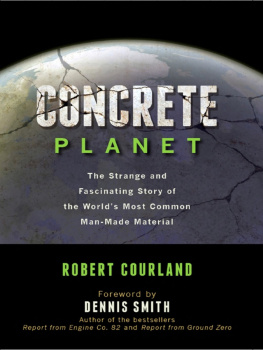No part of this publication may be reproduced, stored in a retrieval system or transmitted, in any form or by any means, electronic, mechanical, photocopying, recording or otherwise, without the prior permission of the publishers.
Concrete and culture : a material history.
1. Concrete Social aspects.
2. Concrete Environmental aspects.
3. Concrete construction History.
I. Title
INTRODUCTION
I STARTED thinking about concrete in the latter stages of writing a previous book, Words and Buildings, which was about how people talk about architecture. Compared to the fugitive, ephemeral world of language, it seemed a relief to turn to something that had substance, where there were physical objects to see and touch. The novelist Graham Greene used to distinguish between his serious works of fiction and those which he called entertainments: this book was to be an entertainment, giving me reason to travel widely, and justifying a visit more or less anywhere. What I did not anticipate were the intellectual difficulties I was letting myself in for although possibly at some subliminal level they were what had attracted me all along. Like language, concrete is a universal medium, found in different forms all over the world, and the problems concrete presents to study are not unlike those of language. Just as with language, it is no good looking at any particular instance unless it can be related to the general condition of the medium: the difficulty, with concrete as with language, is to discover the rules for the general condition.
In so far as there are any accepted principles for concrete, they have generally been assumed to belong with its technical properties, and indeed the bulk of what has been written about concrete has come from engineers and chemists. Most histories of concrete begin with the Romans and their discovery of naturally occurring pozzolanic cements, and continue with the rediscovery of concrete in the nineteenth century and the subsequent invention of steel reinforcement. More interesting to me as a starting point is the description by Sir Thomas More in his Utopia, first published in 1516, of the houses of the Utopians:
More had imagined, long in advance of its invention, a perfect, cement-based building material that would transform peoples lives. Not only does Mores description mark the beginning of a long-standing association between concrete and utopian movements of all kinds, but it makes clear that concrete has a metaphysics as well as a physics, an existence in the mind parallel to its existence in the world. It is the place this medium occupies in our heads that interests me more than its technical properties, and that this book tries to give some account of.
At the period that I became interested in concrete, I was spending a good deal of time in northern Italy and went to see a large number of post-war buildings, many of them built of concrete. A high proportion of these buildings used concrete in ways that can only be described as decorative, in that there was no particular structural reason for many of the features, and they did not correspond to how, according to the architectural orthodoxies that I was familiar with, concrete was supposed to be used. I had read Peter Collinss Concrete of 1959, for many years the only substantial book about the modern architectural use of concrete, and Collins had nothing whatsoever to say about these Italian buildings, or about their non-conformist applications of the medium. That there seemed to be such a large body of work lying off the edge of the map seemed good reason to look further.
Surely there could be a history of concrete that did more than simply repeat the doctrines of architects, most of which in any case, when examined closely, turned out to be full of contradictions? Collinss book, published 50 years ago, although informative about the early years of concrete, was not a good model, since it was so determined to promote as an orthodoxy the very particular approach to concrete of one individual architect, Auguste Perret, whose Parisian apartment building at 25 bis rue Franklin, completed in 1904, is often regarded as a prophetic work for architecture in concrete. There were few exemplars for the sort of enquiry that I had in mind, whether about concrete, or any other building material. Richard Westons Materials, Form and Architecture (2003), an admirable study of architectural Two exceptions, closer to what I was looking for, and specifically about concrete, are the German author Kathrin Bonackers Beton: ein Baustoff wird Schlagwort (1996) and the French historian Cyrille Simonnets Le Bton (2005), the latter published well after I was into the project. Both have been valuable to me. Many of Simonnets ideas coincided with my own, and reading him did much to make my own thoughts clearer; his book, of which I have made extensive use, has made my own a lot better than it would otherwise have been. At the same time, the work of two other francophone historians, Gwenal Delhumeau on the Hennebique archive, and the Canadian Rjean Legault on architectural attitudes towards concrete in France in the early twentieth century, have both been exceptionally useful. But I never wanted to write a book just about architects, nor one limited to only one section of the world part of the interest of concrete is that it is so ubiquitous and, for the most part, so innocent of architecture. Architects and engineers do not have a monopoly over concrete. My wish was to think about concrete in all the diversity of its applications, not just those controlled by architects and engineers, but to deal with its presence everywhere, whether in the work of self-builders, sculptors, writers, politicians, entrepreneurs, photographers or film-makers. For this foolhardy undertaking, there were no precedents.
Concrete is often regarded as a dumb or stupid material, more associated with death than life. Figures of speech in many languages take advantage of this. In German, Beton-Fraktion is used to mean an intransigently stubborn political group; Beton-Kopf, literally concrete head, a reactionary political opponent. And often, when I told people that I was writing a book about concrete, they would raise an eyebrow as if to say, you cant be serious.
These and many other negative associations interest me. A side of concrete has always been repellent. There is an undoubted prejudice against the look and even the feel of Portland cement, wrote the English journal The Builder in 1876, and things have not changed much since, despite there being a lot more of it about. An element of revulsion seems to be a permanent, structural feature of the material. Much of what has been written about concrete has tried either to ignore this, or to convince people that their feelings are mistaken. It is not my purpose to try to explain away the negativity that concrete attracts, nor to persuade people that what they find ugly is really beautiful. This is not an apology for concrete, meant to win people over to it. The many attempts, mostly originating from the cement and concrete industries, to put a better face on concrete strike me as misguided and pointless. There is more sense, I believe, in accepting the dislike people have for concrete for what it is, and in finding room for that repugnance within whatever account of concrete we are able to give.









